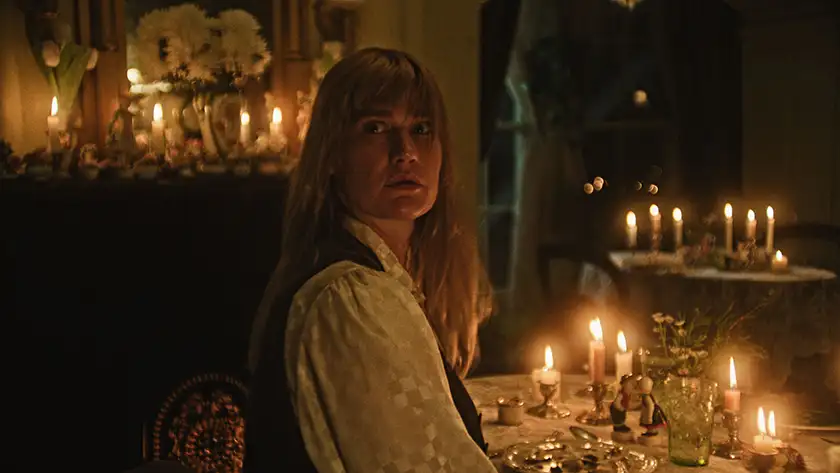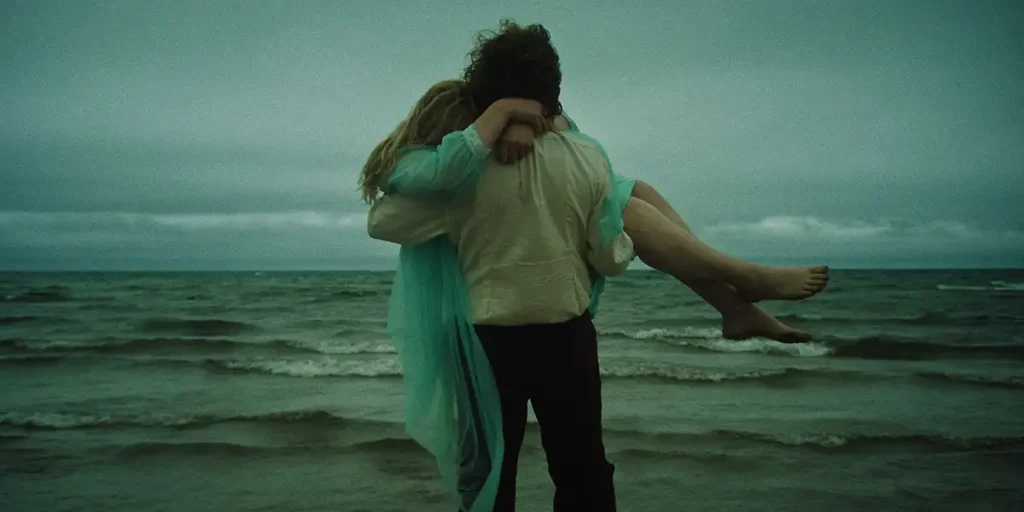With its mystic world-building and distinctive style, Honey Bunch is a peculiar dissection of a marriage that hides ominous undercurrents of obsessive love.
Directors: Madeleine Sims-Fewer & Dusty Mancinelli
Genre: Drama
Run Time: 113′
Berlin Film Festival Screening: February 18, 2025
Release Date: TBA
Our first encounter with the world of Honey Bunch is before we even know who our characters are. A man holds a disabled woman in his arms, gazing at the bleak landscape of an empty beach, carrying her into tumultuous ocean waves, declaring his unconditional love. Despite witnessing the touching moment that the couple shares, you still feel uneasy at the picture before you.
After the opening sequence, writer-director duo Madeleine Sims-Fewer and Dusty Mancinelli gear up to tell you the chilling tale of Diana (Grace Glowicki, of Strawberry Mansion) and Homer’s (Ben Petrie, of BlackBerry) marriage from the moment before it becomes a tale of entrapment.
Diana is a young woman who suffers from crippling pain and memory loss due to an unknown accident. Her loving boyfriend, Homer, is determined to get her to recovery, so he takes her to a remote facility for experimental treatment, where she undergoes innovative therapies to recollect the scattered memories of her trauma. However, the more progress Diana makes, the more she doesn’t feel like herself, while Homer is passionately, almost stubbornly, supportive of the wondrous practices at the facility. Diana’s mistrust towards her husband’s progressively suspicious behavior and her haunting visions at night lead to the unravelling of unnerving truths and sinister secrets about their marriage.
Sims-Fewer and Mancinelli greet the couple and the viewer into a strangely inviting world, built like a serene dream and a hellish nightmare at the same time. The film carries a vividness within its locations, production design, and color palette that puts further stress on the uncanny nature of Diana’s predicament; she’s distanced further and further away from what she knows about herself. The vast treatment facility is engulfed in a deceptive warmth and an intangible dread that slowly slithers its way even into the daylight, making it difficult to trust the hospitality or her husband’s compassion.
The further we descend into the madness of Honey Bunch, the more the imaginativeness of the world-building begins to resemble that of Guillermo del Toro’s prominent extravagant works, mixed with Gore Verbinski’s, particularly A Cure for Wellness.

We, the viewers, don’t know anything about Diana and Homer’s relationship going in. Therefore, we’re to doubt every single thing we’re told through the stylized, quirky dialogue of the couple’s back-and-forths. Homer presents himself as an extremely sympathetic husband, devoted to bettering the life of the woman he cherishes more than anything in the world. Through Petrie’s performance and Sims-Fewer and Mancinelli’s direction, Homer’s adoration masterfully bounces between coming off as tender and manipulative. Both characters are not shy in their declarations of how far they’re willing to go for their love, but the film dares to ask, in a certain unsettling tone, the question: How much is Homer willing to sacrifice to save Diana from her illness? What would be the cost of her recovery?
The answer is not as clear, or as black and white, as the first half of Honey Bunch alludes. As the secrets of the mysterious treatment begin to unpeel like dead skin, the secrets of the trauma that Diana experienced in her past lead to chilling realizations about what has been tucked away for so long in the corners of her memory.
Honey Bunch tries to deliberately confuse you with its tone, which works in the film’s favor as you put together the pieces of what eventually reveals itself to be a whimsical but disturbingly dark exploration of the extremes in a relationship. The line between selflessness and selfishness is completely distorted by the complications of a disquieting twist in the story.
When you look closer between the bright colors of nature and the peculiar interiors, the film becomes an intriguing exercise in sharpening your moral compass on the subject matter of couple dynamics. The offbeat storytelling leaves the viewer in some way detached from Diana and Homer as characters worth rooting for, but pulls the focus in on the larger deterioration of a marriage between two people brought to the bottom of their bottomless love for each other. Honey Bunch treads into nutty territory to stir up reactions on the connotations of three famously chilling words: “I love you.”
Honey Bunch: Movie Plot & Recap
Synopsis:
Diana is taken to a remote treatment center by her husband Homer, who is ready to do anything to cure her of her physical pain and memory loss. As Diana starts gaining her memories back, secrets about her marriage come to the surface, and she begins to feel threatened by everything around her, including her obsessively caring husband.
Pros:
- There’s a unique aesthetic to the world-building, laced with Guillermo del Toro-esque eccentricity.
- Precise and eerie sound design by Matthew Chan.
- An intriguing dive into a complicated subject.
Cons:
- Detachment from the characters. The film doesn’t manage to convince you to care for them.
- Confusing in tone.
- A polarizing third act and resolutions for the characters.
Honey Bunch premiered at the Berlin Film Festival on February 18, 2025. Read our review of Madeleine Sims-Fewer & Dusty Mancinelli’s Violation!

